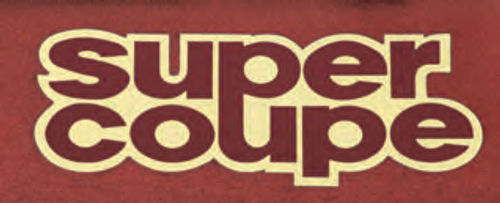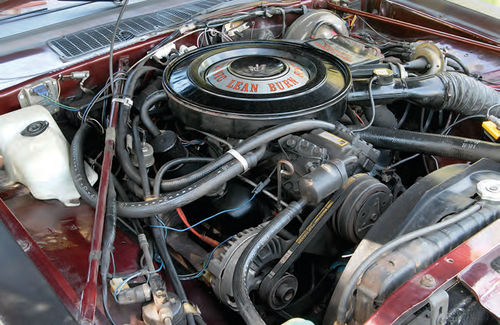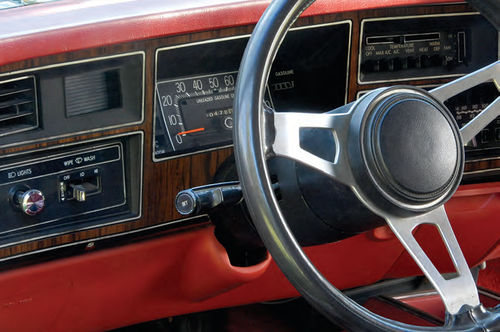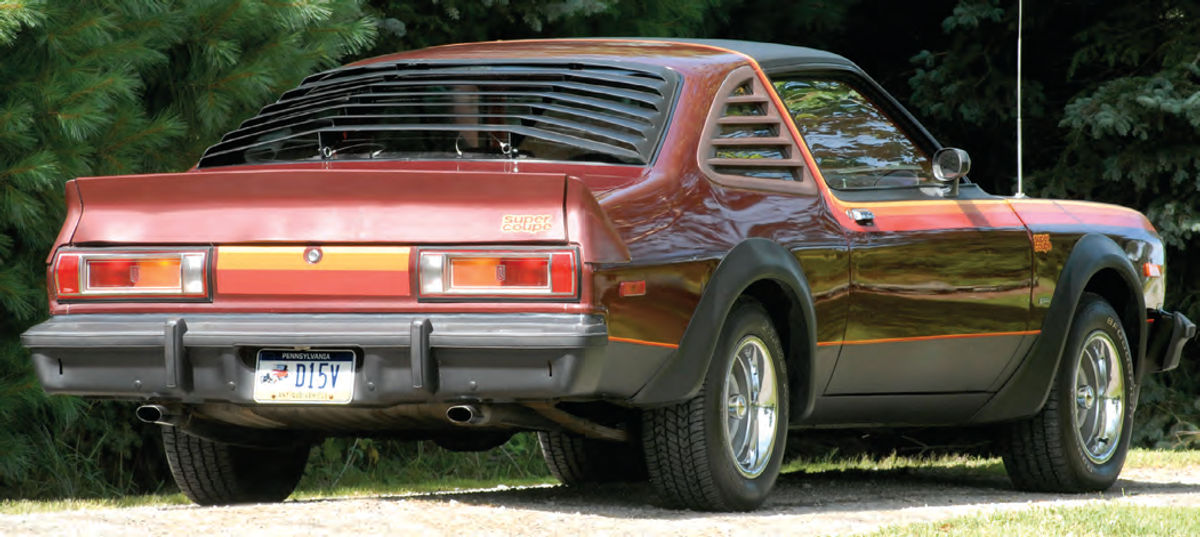1978 Volare Super Coupe

In the Twilight of the Muscle Car Era, It Still Carried a Punch— Along With Special Paint, Wheel Flares and Louvers.
TALKING ABOUT RARE muscle cars might bring up the Dodge D-501, the Ford Talladega or the Chevy Monte Carlo SS-454, but if anyone mentions the Plymouth Volare Super Coupe, it probably would happen far into the conversation.
That’s not too surprising, however, as the Super Coupe arrived in 1978 and never made it beyond that one year. So, how obscure is it today?
“When you’re looking for parts or you discuss that you have a Super Coupe,” said Aaron Yurkanin, whose Volare is featured here, “everyone jumps on the Thunderbird. In the (late) ’80s and ’90s there was a Thunderbird called the Super Coupe, so you have to get through that…”
A Tale of Two Super Coupes
Ford built that model, with a supercharged V-6, from 1989 through 1995. In 1990 alone, it sold almost 24,000 Thunderbird Super Coupes and production never dipped into the hundreds during the car’s entire model run.
On the other hand, the Volare Super Coupe saw just 494 examples in the single year of production and even adding in the nearly identical twin from Dodge doesn’t help much; that division moved just 531 Aspen Super Coupes.
First There Was the Valiant…
The Volare was introduced to replace the compact Valiant—although the two overlapped for the 1976 model year— and that gave it at least a slight disadvantage. The Valiant dated to 1960, was among the first of the Big Three’s compacts and had acquired a good reputation along the way.
Like most of its small American contemporaries, it had been available over its lifetime as everything from a bare-bones economy car to a moderate performer, not to mention that it served as the basis for what was in its day a rather unusual car, the 1964 Barracuda.
The Barracuda gradually moved further from its Valiant roots while the Valiant was joined in 1970 by another variant, the Duster. Something of a mid-range muscle car when properly optioned out, the Duster helped to ensure that Plymouth Had a product line with few gaps and not much duplication.
Through most of that, the Valiants rarely raised anyone’s blood pressure, but they were dependable cars that sold well among those looking for uncomplicated transportation.
From the most economical Valiant 100 with a Slant Six and a three-speed to the top-shelf Brougham with a V-8 and automatic, it meant that the Volare had a lot to live up to even without the performance versions that had been among the Valiant’s derivatives.
Where the Valiant had been there as the muscle-car era was taking off, the Volare arrived as it was fading away. Government regulations and insurance costs had brought about the end, but to different degrees, most American manufacturers were unwilling to give up.
At Plymouth, for example, 1970 saw choices ranging from the 340 Duster and AAR ’Cuda through the Road Runner, Superbird, GTX and the often-overlooked Sport Fury GT, each of which offered its balance of performance, size, luxury and price.
Just four years later, however, changes in the muscle car landscape had reduced Plymouth’s offerings to the Duster, ‘Cuda and Road Runner, but there still seemed reason to hope—muscle cars were still available, albeit in less potent form.
For Plymouth, the Road Runner had been in production since 1968 and tied the division to some of its most serious muscle. As the era wound down, though, the Satellite that had been the basis for the Road Runner was replaced in 1975 by a similarly mid-sized Fury. It was no surprise that Plymouth would use that platform to continue the Road Runner name, but that version proved to be, in effect, a stopgap, as the 1976 model year changed everything when the Road Runner name found another new home on a much different platform.
The Slant Six Road Runner
Plymouth’s decision to apply the badge to the Volare for ’76 was smart. The new car was 6.5 inches shorter in wheelbase and several hundred pounds lighter than the Fury, two facts that certainly seemed to promise some potential in the muscle car’s twilight years.
It demanded little insight to grasp that lower horsepower could be offset at least partially by reduced weight and Plymouth capitalized on that point.
The Volare’s base engine was the faithful 225-cubic-inch Slant Six that dated to the early Valiant days while its optional V-8s were the comparably proven 318 and the 360.
Those who hadn’t quite been able to see where muscle cars were going—or had chosen to ignore the signals— must’ve gotten the message at last. The 1975 Road Runner had been an options package for the Fury and used a 318 as the base engine. The Volare-platform 1976 model’s base engine was the 225.
Still, while a Slant Six Road Runner was docile, one with a V-8 could put some muscle behind the image created by its graphics and body trim. It wouldn’t reach the halo that remained from the name’s golden years, but a properly equipped Volare Road Runner in its day was not a car to be dismissed and Plymouth Had some strong shots left to take.


A Close Look at the Super Coupe
At first glance, a 1978 Volare Super Coupe seemed to be just another Road Runner, but a closer look revealed that aside from the fact that they’re both coupes and they both have stripes, the two diverge. The Super Coupe added blacked-out trim, flares to cover the GR60x15 tires on eight-inch rims and matte black paint for the hood and front half of the roof panel. With a 360 providing 220 horsepower plus a suspension much firmer than that of a garden variety Volare, it was a formidable car in 1978 and probably surprised more than a few stoplight racers.
Like the Super Coupe, the Street Kit Car was based on the Volare, but it’s even less common with just 247 sold alongside of 145 examples of the Dodge version. With its flares and spoilers, not to mention the “360 cu. in.” on each side of the hood and large “43” figures on the doors and roof (think “Richard Petty”), the Volare Street Kit Car actually surpasses the Super Coupe when it comes to being indiscreet, although like the feature car, it does benefit from the unseen but useful heavy-duty suspension. Yurkanin has a Volare Street Kit Car, too, but it’s the Super Coupe that he remembers seeing on the road.
“I recall as a kid seeing them every once in a while,” he said, “and you figure there were only 494 made. That’s 10 per state, so how often would you see one? I’d be thinking ‘man, that’s the coolest car ever’ and then I’d see a Road Runner and I’d say ‘that’s an OK-looking car.’”
It Spent Much Time In Storage
Yurkanin already owned his Street Kit Car when he bought the Super Coupe about five years ago. He’d been looking for one, but expected that any example he found would be too expensive. Then the feature car showed up online from a Florida seller and it was too nice to pass up. The seller had had a ’Cuda, Yurkanin said, but health problems forced him to give it up. An Oklahoma collector wanted the ’Cuda and that’s where the story becomes slightly complicated as it helps to explain the car’s condition.
“He said ‘I’ll take the ’Cuda, but you’ll have to take something from my collection because there’s no space,’” Yurkanin explained. “So the Florida collector got the Super Coupe and this other guy had had it in his collection for quite some time…
1978 Volare Super Coupe
GENERAL
Front-engine, rear-drive, coupe
ENGINE
Type Overhead-valve V-8
Displacement 360 cu. in.
Bore x stroke 4.00 in. x 3.58 in.
Compression ratio (:1) 8.4
Carburetor Four-barrel downdraft
Power 220 hp @ 4000 rpm
Torque 280 lb.-ft. @ 3200 rpm
DRIVETRAIN
Transmission Three-speed automatic
Final drive ratio (:1) 2.76
SUSPENSION & BRAKES
Front Transverse torsion bars
Rear Live axle, leaf springs
Brakes (f/r) Disc/drum
STEERING
Recirculating ball, power-assisted
MEASUREMENTS
Wheelbase 108.5 in.
Length 197.5 in.
Height 53.1 in.
Width 72.8 in.
Track (f/r) 60/58.5 in.
Weight 3255 lb.
“This guy had it for a couple of years down there in Florida and when he got back on his feet, of course, he wanted to go back to his career. He only had a one car garage, so he pulled the Super Coupe out and put it up for sale.”
Some further research showed that the car had earlier been kept in a storage facility and combining that with the ownership by the two collectors supports the 40,000 miles it showed in 1986 at its last state inspection.
With that history in mind, the decision to buy wasn’t a difficult one; a friend flew to Florida and drove the Super Coupe back to Yurkanin home in Pennsylvania. The biggest problem on the trip was a blow-out about a third of the way home, but something that happened the night before the tire failed is probably more telling. Yurkanin said that he learned of the incident while talking to his friend about the blow-out.
“He said, ‘Oh, by the way, I ran into someone who was driving a brand-new Escalade last night around midnight,’” Yurkanin recalled.
“The Escalade driver said ‘I owned one of these when I was a kid and I’ve yet to see another one. I’ll give you $25,000 for it right now.’
“So I thought that was pretty interesting. The guy had the money to back it up, obviously.” Just as obviously, the Super Coupe’s driver politely declined the offer.
“He said, ‘No, no, it’s my friend’s car, he just bought it,’” Yurkanin explained, “and he just kind of left it at that.”
Volare Rust Is Easy to Spot
The rest of the trip home was completely uneventful and in a way, that lack of drama almost summarizes the car. Its only real problems are a slight fuel leak at the carburetor and a very small amount of rust in a known problem area near a taillight. Almost anyone who remembers the Volare and its Dodge partner, the Aspen, in everyday use is likely to be surprised that the feature car has only that one spot, as Volares and Aspens were known for extreme rust.
Yurkanin said that they rust “pretty much everywhere” and if he’s exaggerating, it’s not by much. The problem is worst on earlier models, although it was never eliminated over the Volare’s production run, so a close inspection of the body is the most critical requirement when considering a Super Coupe or any other Volare. Luckily, some of the worst rust is going to be visible at even a casual glance, since the fenders on anything but a dry-climate—or garage-kept and parked-for-the winter—car generally developed large holes, a problem so serious and so widespread that it generated a recall campaign.
Other areas where damage should be easy to spot include the rocker panels, the quarter panels, the door bottoms, the leading edges of the hood and trunk lid. The wheel wells suffered, too, and on a Super Coupe or Street Kit Car with the flares, that’s a double concern; the flares might have trapped road salt and debris when the car was in daily use and then retained moisture, but then they can make inspection of a potential restoration project’s underlying metal very difficult.
Volare floor pans are sometimes damaged and since these are unibody cars, their structural integrity depends on a solid body with strong anchoring and support points for suspension and other major components.
Oddly enough, the Volare’s tendency to rust has turned out to have at least a small benefit to the restorer.
“What I find unique,” Yurkanin said, “is that, owning a couple Chevy Novas of that year, you can’t find a fender, but these Volare fenders are everywhere, NOS. That’s probably because they had that recall and they flooded the market with them...fortunately, this car is nice enough that I don’t need them.”
Mixed Signals on Parts
Finding flares for the car is another matter. Yurkanin has seen only two sets for sale and bought one of them. But surprisingly, the tape stripes are being reproduced. He bought a set of those, too, and installed them, but the flares he bought are extras that are there if he needs them. He recommended checking the condition of the flares and spoilers on a Super Coupe under consideration. They’re key parts of the car, he said, and if they’re at least present, they can probably be repaired.
“They’re plastic,” he said, “so you’d have to repair them like any other piece of plastic.”
Not replacing or repairing them immediately wouldn’t prevent the Super Coupe from running and the car’s heritage presents some significant points in its favor since its rarity stems from the fact that it’s a Super Coupe and has nothing to do with its being a Volare. Under its “Super” skin, nearly every major component was well tested by 1978 because it had served in other cars and the same popularity that proved them created a market for replacement parts and direct substitutes. As an example, Yurkanin said that his car’s distributor was replaced with a correct-appearing upgrade before he bought it and he was given the original as part of his purchase.
Not everything is widely available, of course, but it’s doubtful that the car would ever be out of service for an extended period because a critical part just couldn’t be found.
Like the NOS fenders that Yurkanin said are everywhere, the supply of mechanical and maintenance parts should be of interest to the owner of any Volare whether or not it’s a Super Coupe. If it is a Super Coupe, though, it still has a lot in common with other versions.
Yurkanin recalled that his father bought a new Volare station wagon that had the same dashboard as his Super Coupe has and said that the Super Coupe’s interior is basically that of a Volare or Aspen.
“Except for the console on the Super Coupe,” he added. “That’s the only difference. Not many of the others came with a console.”
Beyond the similar interiors and the straightforward driveline, the Super Coupe shares something else with its more common relatives.
“It’s been so dependable,” Yurkanin said, “that it’s one of the main cars that I would take my kids in to go on a trip.”
He’d prefer not to take his kids, though, because if something did happen out on the road, he wouldn’t want them to be stranded with him. He admitted that he’s probably more worried than necessary and that the car has given him no reason to suspect problems.
“Overly cautious because of the kids,” he said.
But that’s not the same as saying that he worries about the kids being around the car. In fact, he wants them to be around it.
“I think that a car that has stories has value,” he observed. “So if you have a car that you take your kids in, that you go on trips in, then that becomes a part of them. To me, now the car is valuable. Not valuable money-wise, but it’s important.”
His approach apparently works, as his daughter—at seven years old—has effectively claimed the Super Coupe. He’s seen it draw other kids’ attention when he shows it and he believes he knows the source of the attraction.
A Showtime Magnet
“A lot of parents walking around with their kids stop,” he said, “probably for the same reason my kids like it—the bright colors. (The kids) just think it’s really cool.”
Adults notice it, too, but not in all circumstances, as Yurkanin said that it often goes undetected on the highway. It’s probably not being mistaken for an ordinary Volare, but those who see it might take it to be an ordinary Volare that’s been tricked out.
“At a car show,” Yurkanin said, “it’s unique and it gets a lot of attention. When I was at my last car show, there was a couple who had a car that won the category hands down. It was a ’74 or ’75 Cutlass with the swivel seats. It’s like brand-new. There’s no way I would ever win. They sat by their car the whole time and I’m running around the show with the kids getting ice cream or whatever.

“They said they sat there and everybody came up and looked at the Super Coupe,” he said, “they walked right past their car.
“I think that on the road, the Super Coupe gets a little ignored, but at the shows, it gets a little bit more attention.”
He added, however, that while it gets attention at shows, it’s not often recognized and he reiterated that some might assume it’s a standard Volare wearing aftermarket accessories.
“That’s what they probably think initially,” he said, “until they see the book and then the brochures. Then they walk around it, checking it out.”
That’s not as far fetched as it might sound; consider that despite his interest in the Super Coupe, Yurkanin has seen none but his own since those he saw in the late 1970s. He’s heard of others and seen photos of some, but he’s never actually come across another.
“At 494 made,” he said, “there can’t be too many left.”

















